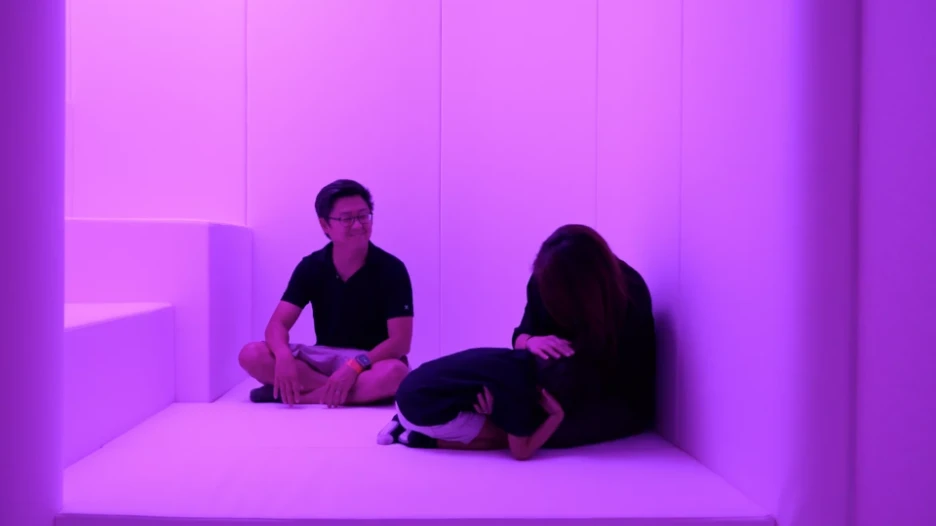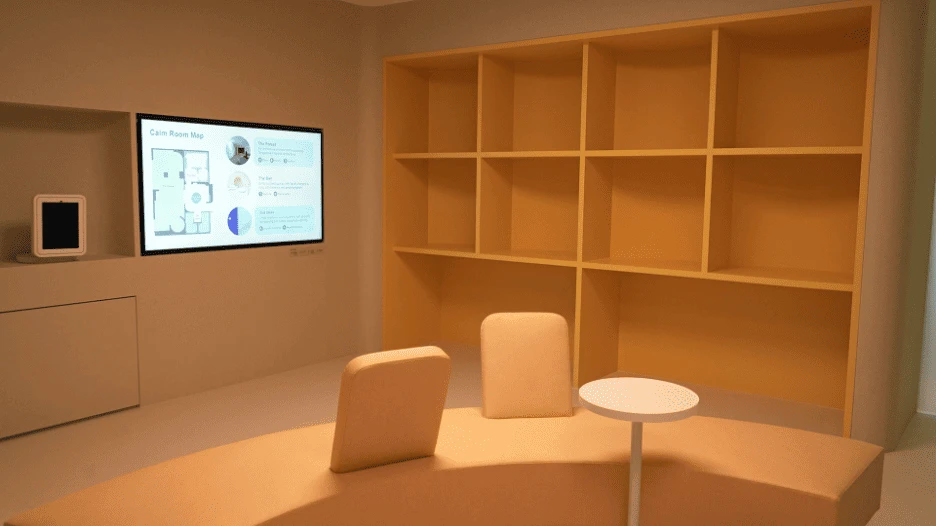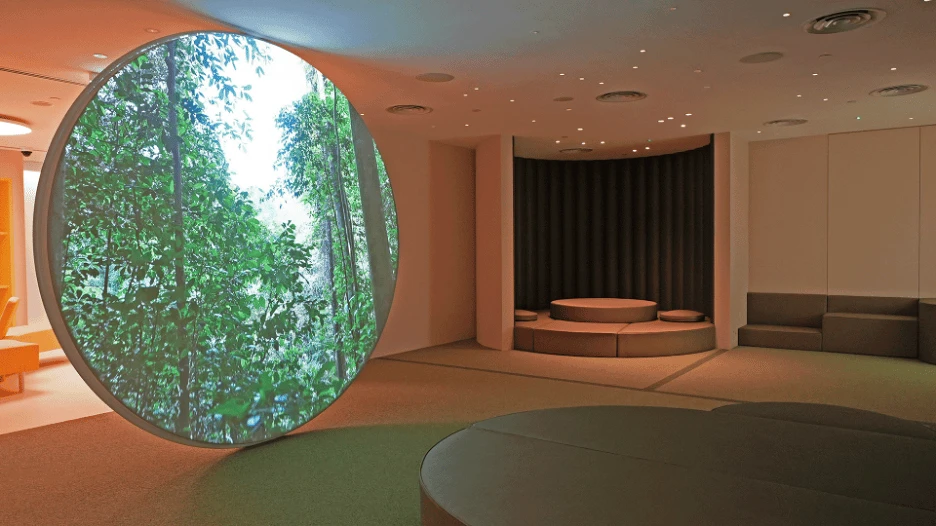Last update: October 27, 2025
Inside Changi Airport’s Calm Room for Neurodivergent Travellers
Airports are full of energy — the rolling of luggage wheels, the hum of boarding calls, the glow of flight screens. For many travellers, it’s all part of the excitement and rhythm of being on the move. But for others, especially those with sensory sensitivities or who are neurodivergent, that same environment can quickly become overwhelming.
That’s why Changi Airport has introduced something special — the Calm Room at Terminal 2. Tucked within the departure transit area, it’s a peaceful haven designed for travellers who may need a quiet space to pause, reset, and recharge before continuing their journey. This isn’t another attraction to explore; it’s a space built with care and understanding, created especially for those who need a bit more calm in the midst of travel.

Image source: Changi Airport
Where and how – Finding the Calm Room
If you’re flying through Terminal 2, you’ll find the Calm Room on Level 2 of the transit area, near the Dreamscape indoor garden, just across from Transfer F. There’s no need to book ahead or request access — simply follow the signs, or ask any member of Changi’s staff, who are trained to assist travellers with accessibility needs.
The Calm Room is open 24 hours a day, designed to be available whenever you need it — whether your flight departs before dawn or lands well past midnight. Travellers can enter freely, and caregivers or family members are welcome to accompany them. You’ll also find small cubby holes to store shoes, bags, or carry-ons — a small but thoughtful touch that keeps the space clean, uncluttered, and restful for everyone.
While the rest of Changi shines with its butterfly gardens, indoor waterfalls, and sensory delights, this space takes the opposite approach. The Calm Room is about quiet simplicity — soft lighting, gentle acoustics, and an environment that avoids overstimulation. If you or your travel companion ever feel overwhelmed after security or during a long transit, this is the one place designed to help you pause, breathe, and recalibrate.
And here’s the heart of it: the Calm Room isn’t an attraction to tick off your list. It’s a safe, empathetic space, created especially for neurodivergent travellers and anyone with sensory challenges — a reminder that in the midst of all the motion and noise, there’s room for calm.
Inside the Calm Room – What to expect inside
Step through the door, and the first thing you will notice is how the noise of the airport fades away. The Calm Room is about 200 square metres of quiet, divided into four thoughtfully designed zones, each catering to different sensory needs.
1. The Welcome Area
This is your transition space, softly lit, with neutral tones and simple seating. Travellers can remove their shoes, store their bags, and take a moment to adjust to the calmer atmosphere before moving deeper into the room. It’s also a gentle signal to your body: The journey has paused; you can exhale now.

Image source: Changi Airport
2. The Forest
As you move in, natural elements take over. The Forest mimics a soothing outdoor environment, with biophilic design features, earthy textures, and greenery-themed visuals. For travellers who find comfort in nature, this area offers grounding through familiar, peaceful cues, like looking out at a garden without stepping into the heat and humidity of Singapore.

Image source: Changi Airport
3. The Den
This space was designed with movement in mind. It has padded walls and soft flooring, allowing travellers, especially children or adults on the autism spectrum, to move, stretch, or self-soothe safely. Here, energy isn’t discouraged; it’s understood. The Den is where parents can let kids release built-up tension or where adults can manage sensory overload in a controlled environment.

Image source: Changi Airport
4. The Nest
Finally, there’s The Nest, the quietest and most private of all zones. It’s dimly lit, acoustically insulated, and equipped with adjustable lighting controls. For travellers who need complete calm, this space provides privacy and the ability to regulate sensory input on their own terms.
Each zone flows naturally into the next, offering a progression from mild stimulation to total calm. The entire room is unmanned but monitored discreetly, ensuring safety without intrusion. From its curved walls to the absence of sharp edges or harsh lights, everything in the Calm Room was created for comfort, regulation, and dignity.
It’s not a space for selfies or sightseeing; it’s a thoughtful pause in the middle of the world’s busiest airport, a design that quietly says, you belong here too.

Image source: Changi Airport
Making memories & tips
Traveling through an airport like Changi can be exhilarating or exhausting, depending on your sensory threshold. For neurodivergent travellers or those with sensory sensitivities, a few small strategies can make the experience smoother and more comfortable.
Plan for calm before you need it
If you know that long lines, bright lights, or sudden sounds can be overwhelming, try visiting the Calm Room before sensory overload sets in. Think of it as part of your travel routine, just like grabbing a snack or stretching your legs. Even ten quiet minutes can make a big difference before boarding a long flight.
Pack your personal comfort kit
Bring along familiar items that help you regulate, noise-cancelling headphones, a favourite fidget tool, or a small weighted item. The Calm Room allows carry-ons, so keeping these nearby makes it easier to settle in without having to unpack your entire bag.
For families and caregivers
Travelling with children who have sensory needs can be especially challenging. The Den, with its padded walls and safe, movement-friendly setup, is a gift. Let kids move freely or unwind here after a long stretch of sitting still. Adults who need a quieter environment can use The Nest to decompress, while caregivers rest nearby. There’s no judgment here, only understanding.
Use your transit time wisely
If your layover is long, alternate between sensory rest and gentle exploration. Once you’ve had your moment of calm, explore other accessible features of Changi. Wheelchair-friendly routes, spacious restrooms, and clearly marked elevators make it easy to navigate. You can also enjoy the Dreamscape indoor garden right next to the Calm Room, which offers lush greenery and soft ambient sounds, a visual treat without sensory overload.

Image source: Changi Airport
Respect the purpose of the space
While the Calm Room might sound inviting to anyone craving quiet, it’s not a general lounge. It was created specifically for travellers with sensory sensitivities or neurodiverse needs. Using it respectfully ensures that those who truly need it can find relief when it matters most.
Travelling can be unpredictable, but a space like this helps transform what could be an anxious journey into one of comfort and reassurance. Sometimes, the best travel memories aren’t about landmarks or photos; they’re about moments when you feel truly understood and cared for, even in transit.
A quiet step forward for inclusive travel
Amid the rush of boarding calls and rolling suitcases, the Calm Room stands as a quiet reminder that travel can be inclusive for everyone.
This isn’t a luxury or attraction, but a space built with empathy — for neurodivergent travellers and those with sensory sensitivities who need a moment of calm. With its soft lighting and gentle design, it offers comfort, dignity, and the chance to breathe before continuing the journey.
By creating it, Changi shows that accessibility isn’t only about physical access — it’s about understanding invisible needs too. In a busy airport that never sleeps, this quiet corner leads the way in inclusive travel, proving that sometimes, the most meaningful innovation simply listens.